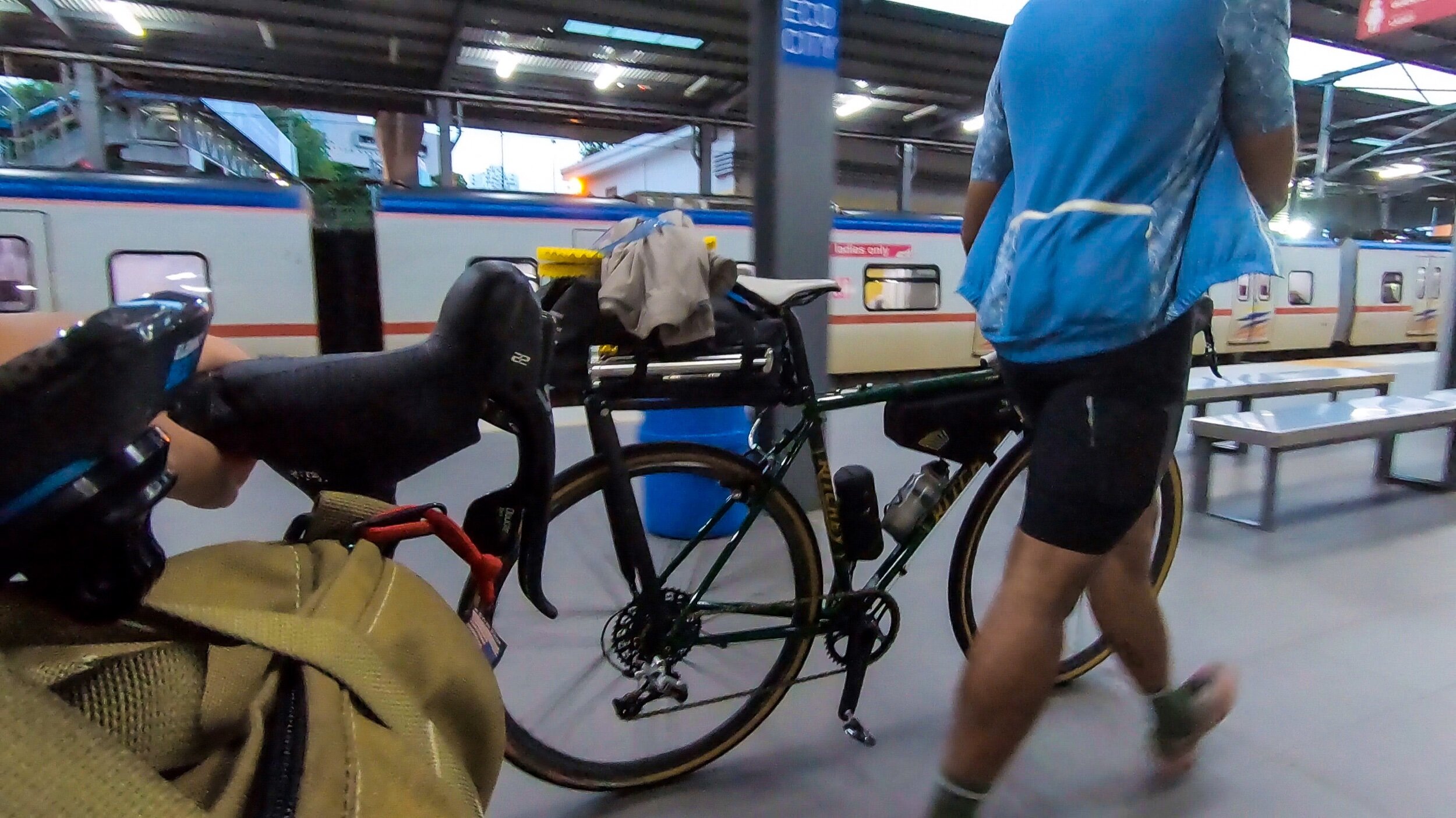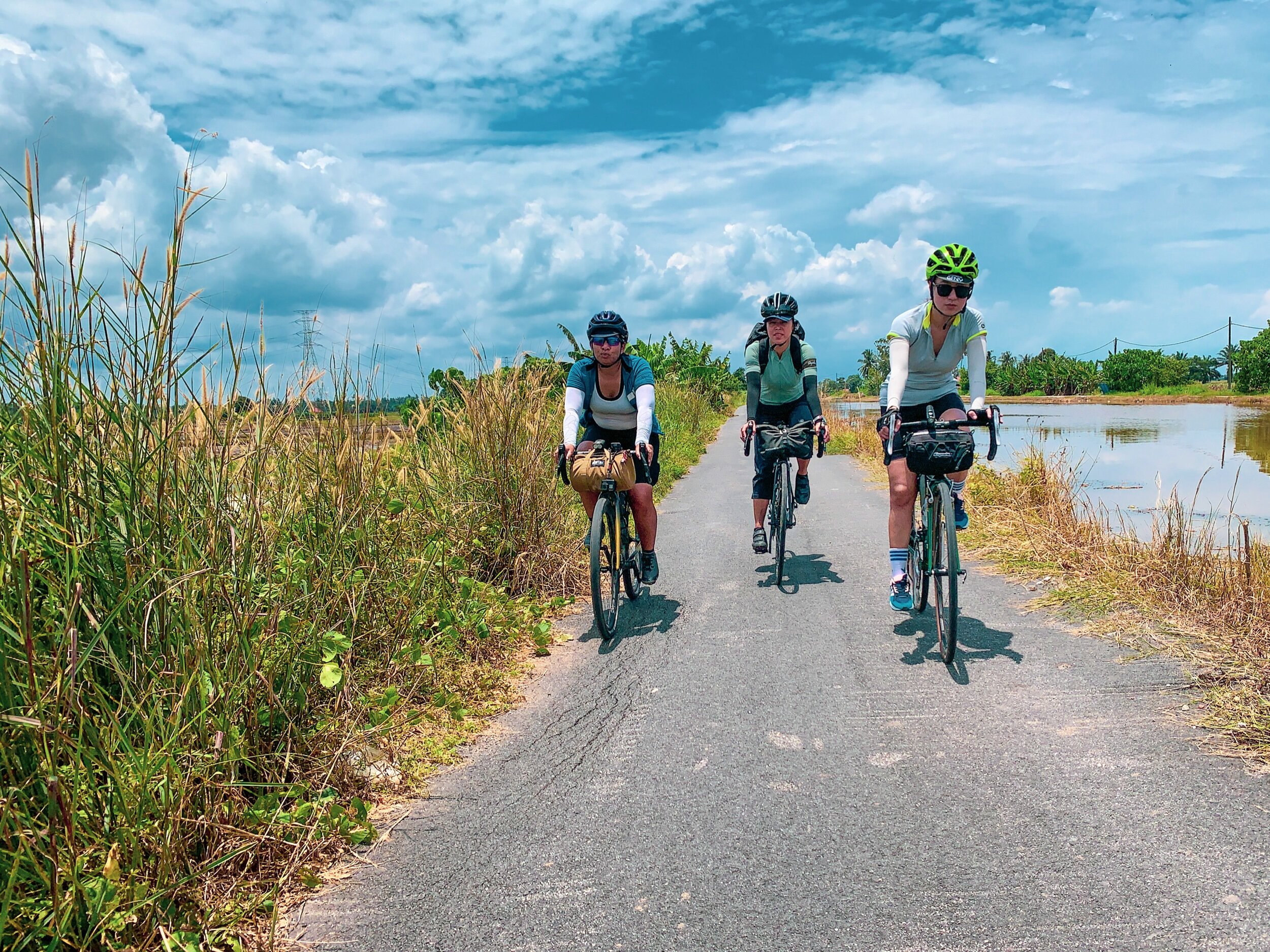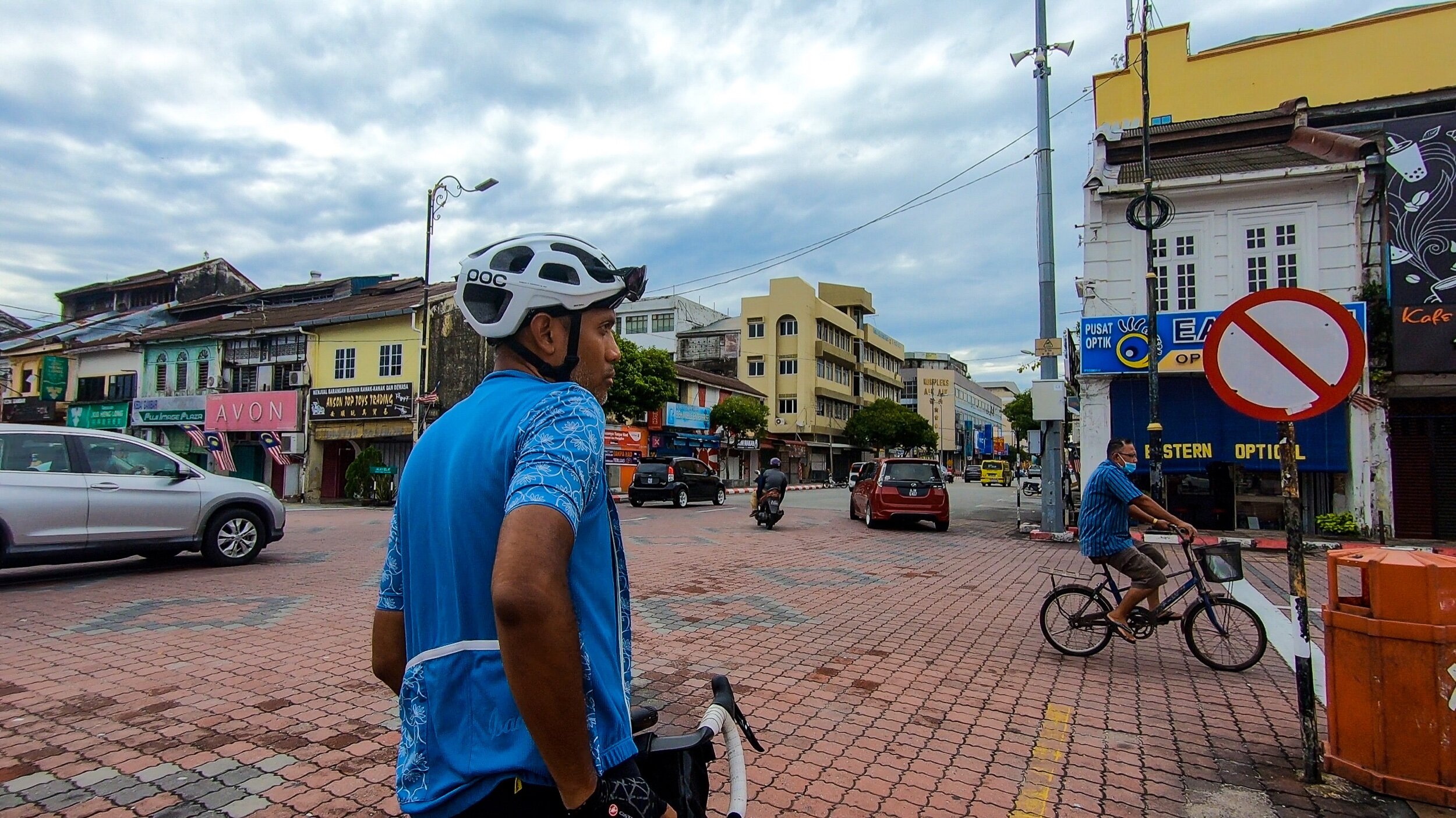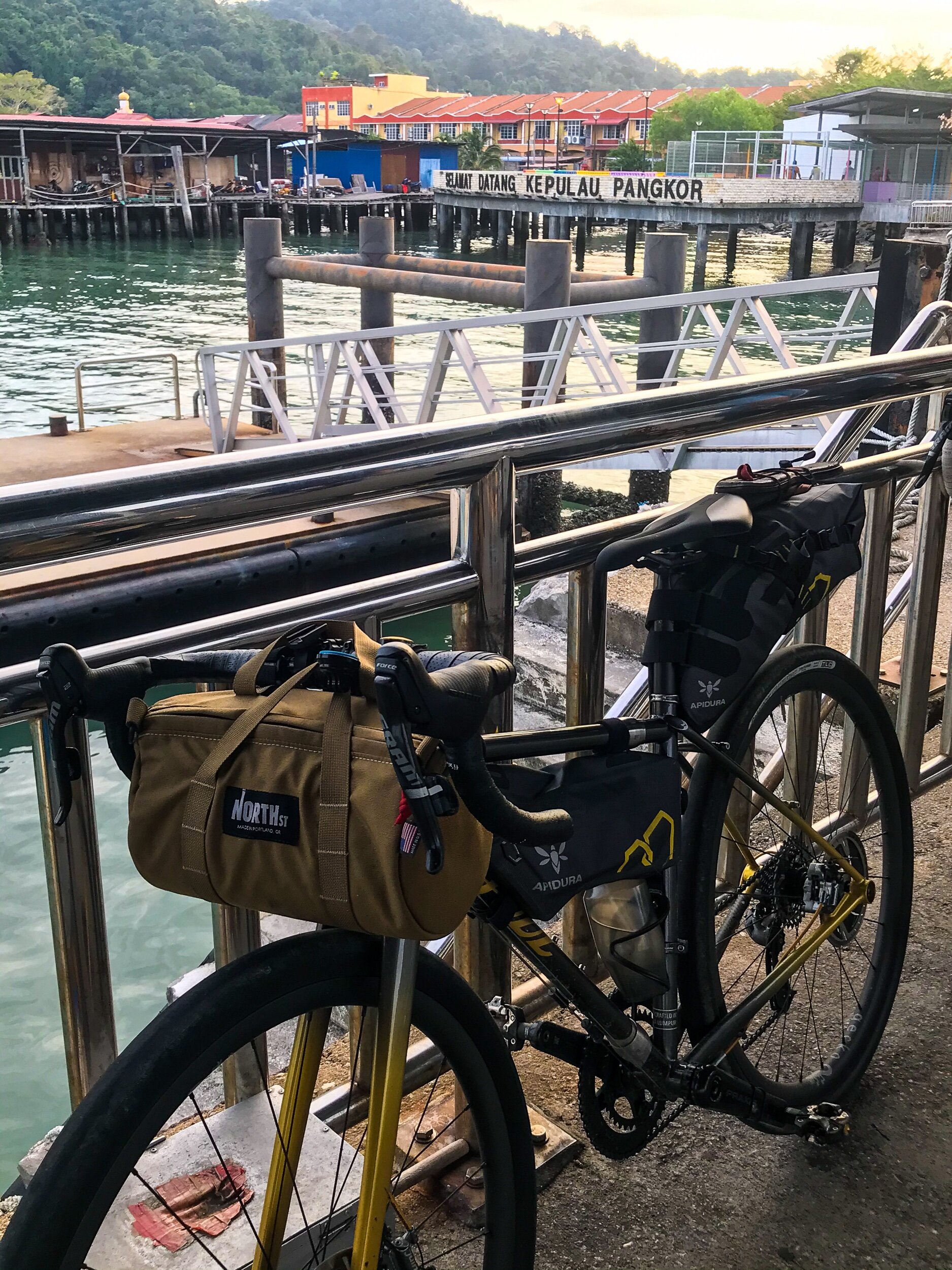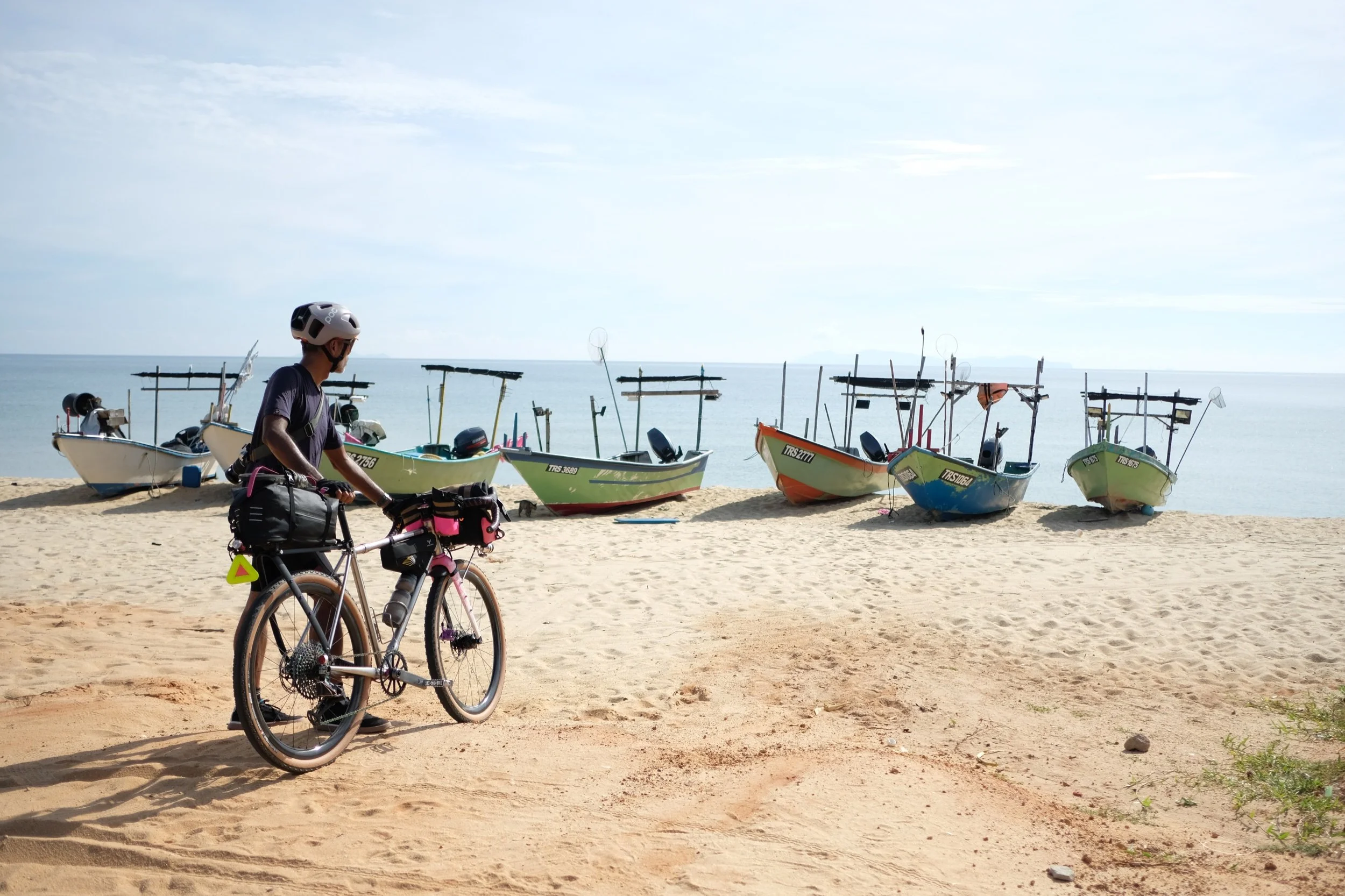Cycling Malaysia’s West Coast from Klang to Pangkor Island
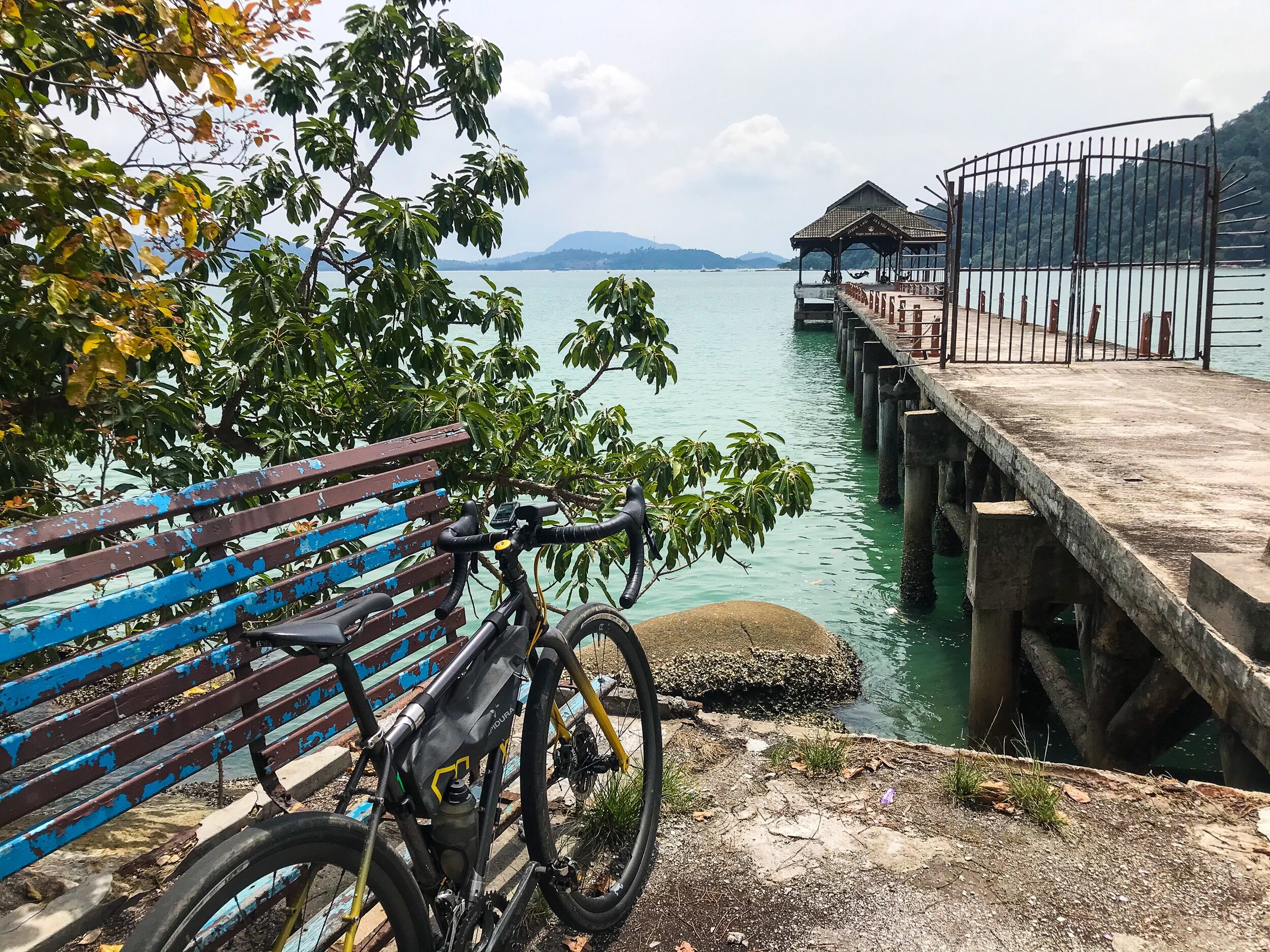
Pangkor Island is a somewhat underrated island on Malaysia’s west coast with a thriving local fishing industry and quiet beaches for weekenders who prefer locations somewhat off the tourism radar. Situated in Perak’s Manjung district in between Kuala Lumpur and Penang, the island is a historical spot of strategic colonial importance, witnessing the signing of the Pangkor Treaty between the British and the Sultan of Perak in 1874, effectively starting British rule in Malaya.
After years of avoiding cycle touring locally in Malaysia due to the insane midday heat of our climate, I had finally been pushed into a corner in the year 2020. No thanks to covid-19 and the international travel ban worldwide, it was inevitable that I would have to finally cave in and do it. After all, it could very well be years before Eka, Maya or myself could venture out of our respective countries again, something that we (like many others around the globe) looked forward to more than once a year.
So after the first phase of Malaysia’s Movement Control Order eased up and state borders were opened, we set about planning a quick escape to a nearby beach destination. The goal was to leave our cars at home much like our weekend in Kuala Kubu Bahru with the Marin bikes, and get there by bike and/or other public transport. We ruled out beaches in Selangor state since we often cycle to the beaches like Morib and Tanjung Sepat regularly, meaning the next two nearby options would either be Negeri Sembilan or Perak.
In Negeri Sembilan we could opt for Port Dickson, but the beachside getaway is on the mainland itself and accessible without taking a ferry, therefore more likely to be crowded with families. Considering the pandemic and the need for social distancing, we opted for Pangkor Island in Perak instead. We had not been there in quite a few years since our favourite hotel had been closed for renovations and never reopened, but a number of new places to stay had popped up since our last visit. A trip to Pangkor Island also required a ferry ride which made it a bit more of a hassle for normal weekenders compared to Port Dickson.
How to get to Pangkor
In terms of distance, Pangkor Island would require more hours in the saddle than Port Dickson, but we were up for the challenge. The most obvious way to get to Pangkor is to take the KTM Komuter train to the Selangor/Perak border station of Tanjung Malim and ride 200km to Lumut, then board a ferry to the island. This would mean riding along the main trunk road that goes up north in the same direction as the larger North-South highway. But obviously we would not be doing that, as it’s not the most pleasant of routes.
If you’ve been a long term reader of our cycling trips and (mis)adventures, you’ll know that Eka and myself are huge fans of taking the scenic route and will swear off any major busy roads even if it is the most direct and time efficient way to get to our destination. For our Pangkor Island getaway, we plotted a three day journey that would start with a train ride out of Kuala Lumpur, before cycling over three days from Klang to Sekinchan, then Teluk Intan, Lumut and the island itself.
The three day journey was relatively mild in terms of difficulty, since the roads were flat and 70% smooth tarmac, minus some inner village roads and gentle gravel tracks. The real challenge was to manage the heat, since the west coast does get pretty toasty during the day. However, it wouldn’t be anything that a cyclist with a reasonable amount of endurance couldn’t handle with proper pacing.
Day 1 Klang to Sekinchan
Distance 95km
Climbing 124m
Difficulty Easy
This first day would mean crossing through most of Selangor state from our starting point in Klang. We took the first KTM Komuter train out of KL from the nearby deserted Abdullah Hukum station, having no trouble dealing with a station master that was nowhere to be seen. It was just after sunrise and despite it being a weekday, we knew that we would have no issues considering the empty station and train itself.
We had initially agreed upon a rendezvous onboard the first train scheduled for the day. However, our friend Fiona met us at the station after missing the train at her initial stop, while our other friend Treas would board several stops later along the line. Upon reaching Klang station we had a quick toilet break and breakfast power up at a mamak restaurant just across the road in true Malaysian style. Once done, it was time to hit the road.
It was a lovely morning, with a light sprinkle of rain making us pull out our rain shells as we rode out from Klang’s historical district. The KTM station is right at the edge of town, and we were soon leaving the busy areas for quieter roads. Heading northwest, we rode past Kapar and soon crossed into Jeram and the coastal areas surrounding Pantai Remis. We didn’t linger, as this was along our normal weekend cycling route and we had already earmarked a lunch spot in Kuala Selangor. Read our feature of Selangor’s forgotten railway for a guide to a day ride to Kuala Selangor.
We had a quick cendol pitstop approximately 10 kilometres to Kuala Selangor, but by the 50 kilometre mark we’d reached the old town square, making a beeline to Auntie Kopitiam which we hadn’t been to in a while since it was shut for a while during the pandemic. The chicken chop here is decent, but they also have a range of other local dishes that are pretty tasty. Portions aren’t too huge for the traveling cyclist, but having had a light breakfast earlier, we felt a hankering for a bit more food and moved over to the delightful Cafe Lumiere, which only opens at noon and always too late when we’re on our Kuala Selangor single day rides.
After a delicious meal of lasagna, a good chat with the owner and dispensing some crucial attention to the resident cat, we reluctantly admitted that it was time to make a move. 20 kilometres later we’d reached Tanjung Karang, as the sun came out to remind us of the weather we’d be facing the rest of our journey on this tour. We’d been fortunate with overcast conditions most of the day, but it looked like our luck had finally run out. Thankfully there were many inner roads that cut through plantations and kampung areas that gave us much needed shade.
Riding a further 15 kilometres took us to Pantai Redang, a popular weekend spot and seafood hive for the locals in the surrounding areas. This is where the infamous Sekinchan Wishing Tree and the accompanying Datuk Kong Temple dedicated to the worship of a local earth spirit/deity can be found, though we had to give these a miss to arrive at our accommodation before sunset. Having taken a slightly longer lunch than perhaps necessary, we wanted to make sure we reached the paddy fields before the waning afternoon light changed to dark.
Crossing a pedestrian bridge took us away from the coast, and further into the vast swathes of paddy fields that were emerald green and not yet ripe for the harvest. Some patches in the bunded plots were still empty, but it was a good time of the year to be in Sekinchan nonetheless. Our accommodation was the instagram-worthy Padibox, a container hotel where we’d pre-booked a family room with large windows overlooking the paddy fields. Imran made an appearance for the evening, since too many work commitments had forced him to miss this tour.
A sunset ride among the paddy fields was cut short by the impending darkness and the unavoidable swarm of gnats attracted to our headlamps. Afterwards, we had a dinner of seafood while desperately swatting away mosquitos in between bites of food (always book a table near a fan!). We had a few moments of relaxation with a view of the paddy illuminated by well placed lights. If you’re paying attention, you could also catch some fireflies darting around between the stalks. As I nodded off to sleep my last thought was that the night time scenery was somewhat reminiscent of my last trip to Bali, mere months before the first covid19 outbreak.
Day 2 Sekinchan to Teluk Intan
Distance 84km
Climbing 102m
Difficulty Easy
The day began with a quick goodbye to Imran and breakfast at a local kopitiam in town, where there is a concentration of chinese morning delicacies. Do keep in mind that most residents in this agricultural and fishing area tend to begin their days early, and the most popular dishes will be finished if you’re there later than the early birds. There’s plenty on the menu though, and traditional vegetarian/vegan options exist for those with food restrictions.
Sekinchan itself being a Chinese word (translating to “village suitable for plantation”) means that the local population is predominantly Chinese, with Hokkien the most widely spoken language here. Cantonese and Mandarin are also widely understood. We had no issues ordering breakfast thanks to Treas, who was our secret weapon for our Taiwan east coast tour. However, the locals should be able to converse in either malay and english enough for you to order despite not speaking any Chinese dialects.
After breakfast it became apparent that this would be a full day out in the sun, something we mentally prepared for as we began to ride through the paddy fields. We were very near the coast by now, which meant the day’s journey would be heading more north than north west. As we cycled we noticed more planting of paddy seedlings in the fields, one reason why some of the patches were still devoid of new paddy growth since the last harvest.
I should mention here that since Sekinchan is one of the major rice producing areas in Malaysia, the paddy fields stretch out as far as the eye can see all the way to the horizon. This means if you’re riding in the area throughout midday, you will get roasted quite nicely by the sun in these wide exposed areas. Take note to bring enough sunscreen or any garments necessary for cover from the blazing sun. Besides the paddy fields, you can also spot some rice millers in the area where you can purchase locally produced rice.
Cutting in and out of the paved road we would every now and then deviate to the gravel paths through the fields. It would be 36 kilometres before we would reach Sungai Besar, where we found a quiet food stop at the edge of a village to have a small lunch of mixed rice, freshly fried tea snacks and (a number of) drinks. Since it was a hot day, 12 kilometres later we had another stop along the main trunk road in Sabak Bernam for more drinks and a second small lunch of deep fried crispy fish with rice.
By then we’d covered nearly 49 kilometres in total, and the next stretch was a trunk road where we moved into a peloton position and made up good time for a later-than-usual start to the day. This part of the journey saw us cross the state border from Selangor to Perak, but was forgettable to say the least. It was a relatively straight logistics stretch with more traffic and heavier vehicles, and we made only one stop at a petrol station at the 70 kilometre mark for any drink refills or snacks.
From there it was another 10 kilometres to our final checkpoint, a lookout point at the edge of Teluk Intan on the banks of the Perak River, the second longest river in Peninsular Malaysia after Pahang River. I once had a friend correct me when I said Teluk Intan, telling me it should be Teluk Anson instead. However, the place was originally called Teluk Mak Intan after a well known female trader from Mandailing, Sumatera and only renamed Anson in honour of a British official who drew up the plan for the modern township, so I’d rather use the original name.
While the information regarding this “Intan” person is somewhat varied, the most widely accepted version of the story is that she was a trader who first established the area in the early 19th century. This helped set up a vibrant trading port there, prompting many people from her native Mandailing to move there, as well as others from Jawa, Rawa, Minangkabau, Kampar and even India-Bombay.
Whatever you call it, the area is also historically important as a place where the Perak rulers once held court before Kuala Kangsar became the royal town itself, and its colonial history too. We had a brief wander around the main town square surrounding the leaning tower before heading to K Hotel for the night, some 4 kilometres away. Dinner was a fantastic steaming, heaped plate of either fried rice or kuey teow at a local mamak nearby, which while not actually on the list of local specialties, was still pretty darn good!
Day 3 Teluk Intan to Lumut + Pangkor
Distance 76km + 9km
Climbing 106m
Difficulty Easy
After two somewhat uneventful days, a small problem made itself apparent the morning before our departure on day 3. Treas’ bike had picked up a slow leak overnight, with the tyre deflating again as soon as we replaced the tube and reinflated the tyre. Clearly it was not a simple repair job, so off we went in search of a bicycle shop that was more prepared to deal with the issue. The first shop took one look at our bikes and declared they didn’t service these sort, but Teluk Intan being a popular cyclist stopover, there were other options available.
More than a simple puncture, we found that a nick in the inner rim needed to be sanded down before the rim tape could be replaced and a fresh tube could be installed. While this took a bit more time than we expected, we took it all in stride since it is all part of the unpredictable nature of touring. The day’s journey was also the shortest of the three days, and all we had to be worried about was ensuring we reached Lumut jetty in time for the last ferry to Pangkor.
But first things first. You can’t stopover in Teluk Intan without trying at least ONE local delicacy the town is famous for. We’d missed the timing for the daytime foods after arriving in the early evening yesterday, but some glorious curry mee was available for breakfast at Restoran Joon Heng Long. Once Treas’ bike was in the condition to move again, we made our first pit stop for a hearty bowl each with the local kopitiam coffee that comes in the signature beige cup with flowers on it. The savoury and rich curry mee was so good that it made up for all the other dishes we did not get to sample, and we always reason that it makes another visit (and another bike tour) necessary.
Leaving Teluk Intan, the road roughly followed Sungai Perak’s direction flowing towards the Straits of Malacca, going over a bridge at the 14km mark to cross the river and continue northwest. After the bridge, a lot of roadworks to widen the road turned out to be a blessing in disguise, because the partially paved side was closed to normal traffic but easily accessible to cyclists. This stretch was open to the elements, but there were some places to stop along the way for water and food refills, including petrol stations.
Eventually we peeled off into an inner road for a change of scenery, going through more quiet kampungs and oil palm plantation areas. Traffic was scarce around these rural spots, as well as several other housing areas that we rode through. At the 46km mark our lunch spot surprised us in the shape of a small hand written sign board directing us towards a small jetty that served the local fishing village.
We took the small turn-off with our bellies now rumbling again, and upon receiving our food we were not disappointed. The prawn noodles advertised on the somewhat underwhelming sign was a perfectly balanced bowl of noodles in a hearty, savoury broth with a tinge of sweetness. We opted for the bigger prawns as recommended; the succulent, sweet and fresh crustaceans were cooked to perfection and paired with the rest of the dish incredibly well. If you’re ever on your way to Lumut (or not) these noodles are worth the detour from the main road.
Satisfied, we continued on our way. The rest of the road would follow the coastline without actually seeing it, though the kampung areas were pleasant enough to ride through with some beautiful traditional wooden houses to distract you. We had some navigation issues along the way but 67 kilometres into the journey we’d reached the Seri Manjung housing area and remained on course. Lumut was approximately 5 kilometres further, but to reach the jetty that berths ferries taking travelers to Pangkor Island would require yet another 4 kilometres with a bit of climbing around the perimeter of the Lumut forest reserve area.
Clocking slightly over 76 kilometres we reached the jetty in time to book tickets to board the final ferry to the island. If you’ve not booked your accommodation on the island upon arrival at the ferry terminal there will be agents offering deals to you, but we had already pre-booked our hotel in advance to ensure that we had no nasty surprises upon arrival. We certainly didn’t want to arrive at our chosen hotel dusty, sweaty and exhausted to find out that all their rooms had been fully taken up!
While waiting for our ferry we had some drinks and snacks at the local food court across the road, accompanied by some decent buskers playing live music. We then had a quick pee break at the clean toilets at the jetty before heading into the platform to board the vessel. The ferry service staff will ask you to remove any valuables from your bikes and help to bring them onboard for you. The bikes will be leaning against the railing on the bow in front, so do add any padding that will safeguard your frame from damage. The staff will also unload the bikes upon arrival in Pangkor, and they will be waiting for you at the ferry terminal upon disembarking.
Pangkor Island
From the ferry terminal we had another 9km to go to Hotel Casuarina, which was on the northern side of the island near the Pangkor Airport which is still closed (hope it stays closed, honestly!). Our point of arrival would be on the eastern shores, but our chosen route would cut across to the west in a horizontal line and follow the coastal road in a clockwise direction all the way to the hotel as the sun set on our left. You could take the shorter route of going straight up from the jetty and continue counter clockwise to the hotel but this part of the road is where you will find a number of insane climbs that will be pretty tough even for cyclists with decent fitness levels.
Pangkor is relatively untouched by massive development after all, which means the road system there largely follows the undulating natural terrain with some nice ascents to leave you breathless (especially for tourers riding with load!). We made a celebratory dinner pitstop at Daddy’s Cafe since it was along the way - one of the best places to eat on the island - and from there it was an easy chill ride in the dark to our accommodation.
For this particular trip, we spent most of our last day being lazy beach bums, although Eka and Fiona managed to peel themselves away for a few hours of exploring the island with their bikes. To be fair, Pangkor Island deserves an in-depth write-up of its own, so we will take the opportunity (and a good excuse) to plan another trip and take a bit more time to explore Pangkor itself.
Full route details
To see the full route details for our trip, the entire collection can be viewed on Komoot.
Stay tuned for our feature on Pangkor, which we will only post after another thorough exploration of the island.
If you liked this tour write up, consider giving these other tours a read too:
Cycling Malaysia’s East Coast, Kelantan to Terengganu
Cycling Butterworth to Langkawi
We also have a number of international tours if you’re looking for ideas to travel abroad:
Cycling Spain’s Andalucia 2017
Cycling Taiwan’s East Rift Valley, Jiufen and Houtong 2019
Cycling Seoul to Busan, South Korea 2019
Cycling Shikoku, Japan 2.0 2022
Cycling Northeast Taiwan 2023

